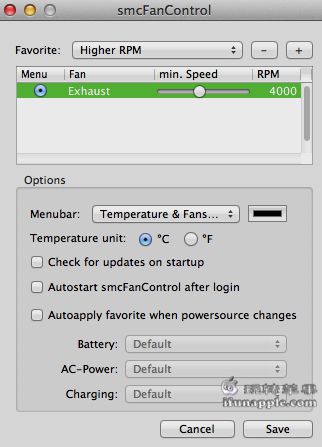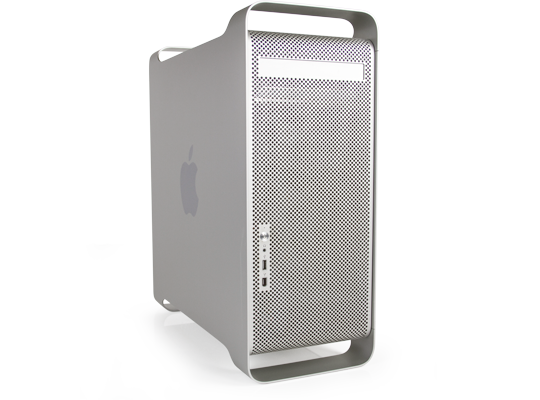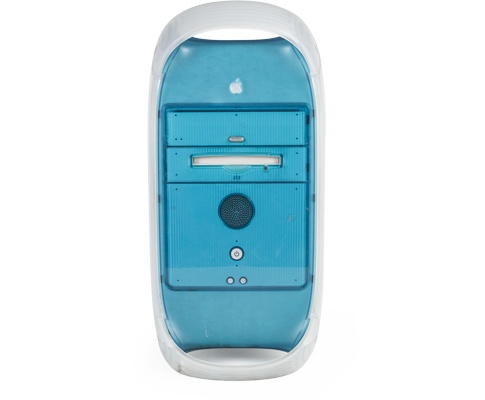

- #Smcfancontrol for power mac for mac
- #Smcfancontrol for power mac install
- #Smcfancontrol for power mac full
- #Smcfancontrol for power mac pro
- #Smcfancontrol for power mac Pc
#Smcfancontrol for power mac pro
My 2006 Macbook Pro has been making noise (mostly when I browse busy web pages) for awhile, but I need it for work and can't turn it in for long. WD40 is NOT a lubricant, but rather a water displacer. Don't substitute WD40 for a real lubricant the way No Film School did. I bet it will work fine! I wish I had read the The No Film School comment before ordering a new fan, but I am back in business either way. I will save it and try it out if the new fan starts acting up. After putting the new on in, I took my old one apart and applied a minuscule amount of 3-in-1 oil to the shaft. Looks like a reasonable alternative to a $50 replacement (I bet the factory in China got no more than a buck or two for this fan!). However, after finishing the job I read the comment above from No Film School and checked out the link. This is a great resource, and the new one went in without a hitch. The noise was only bad when the rpm ramped up, so I put off dealing with it for several days until I finally ordered a new one from Powerbook Medic. At first I feared it was my hard disk, but once I determined the location I realized it was the fan, I did a search that took me to this site and the video. My left fan started making a God-awful noise a week ago.
#Smcfancontrol for power mac full
Of course, in the full experience it did cost me the price of the 500GB drive, but then that is incredibly useful, so I'm not complaining. With the machine fully assembled again I have that eerie silence that you experienced after fitting the new fan, only without having to buy a fan! I put things back together again, and now the right side fan has no vibration when in place, same as the left side one. So I squirted it with a tiny amount of WD-40. That really only left the shaft of the fan to blame. I looked at the plastic fins, hoping to see an imbalance there, but they seemed ok. I next tried putting some electrical tape between the fan plate and the metal holder thingy, but that didn't improve things at all. The left side fan doesn't vibrate at all. All of the noise had gone away, but there was still some vibration. I went further still, and removed the silver plate that you had removed too, and ran the machine again.

Doing that helped prove that the fan was vibrating within itself, and not just vibrating when in place. When I got into the fan area I decided to be even more bold than you had been, and I ran my machine with the fan removed, but still connected. Having changed the internal drive I was already familiar with all the screws to undo. It sounded so dire that I thought my hard drive was dying, and so I've upgraded the 200GB drive to a 500GB, and retired the existing drive to an external enclosure. I've had the dreaded noise for a little while, only mine was from, it turns out, the right side fan. Well, your wallet won't laugh so much, but you will.

But you're going to laugh at how I solved the noise problem. This is a listing of all casks available from the cask tap via the Homebrew package manager for macOS.Firstly, thanks so much for this page, it set me off in the right direction. SmcFanControl lets the user set the minimum speed of the build-in fans. Im a developer and often times I need to compile some packages or maybe even run some codes for couple of hours.
#Smcfancontrol for power mac Pc
If you've got burnt thighs from an old MacBook Pro or you notice that your computer is always overheating and crashing from using CPU-intensive apps (like playing PC games in a virtual Windows environment), you might want to check out smcFanControl.
#Smcfancontrol for power mac install
Recently I have noticed that whenever I use Homebrew to install something, it defaults to source, and compilation causes my CPU temp to go around 98 Celsius. Some of the compiles are quite long, couple of minutes, and Im worried this might harm my MacBookAir. This free, GPL-licensed utility has a single purpose: letting you increase the minimum speed of built-in fans, so your Intel computer will run cooler. SmcFanControl lets you monitor the current temperature (in Celsius or Fahrenheit), assign different minimum speeds for each fan using sliders, and even apply different settings when your power source changes (for example, going back to default fan speed when using battery power).
#Smcfancontrol for power mac for mac
If you looking on the internet a smcFanControl For Mac So, you come to the right place now a day shares with you an amazing application for Mac user-customized settings for your mac fans and show the temperature and speed of the fan on the menu’s bar. As with any settings-tinkering software, you'll want to use smcFanControl judiciously-but fortunately this application always keeps fans in automatic mode (so speed will increase along with CPU load) and never lets you set the fan speed below the Apple-recommended minimum.


 0 kommentar(er)
0 kommentar(er)
